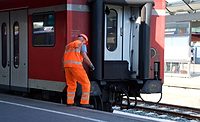U.S. Department of Transportation Secretary Ray LaHood announced the 42 construction projects and 33 planning projects which were awarded funding under the second round of the Transportation Investment Generating Economic Recovery (TIGER) grant program for major infrastructure projects ranging from highways and bridges, to transit, rail and ports. Of the $600 million in available TIGER II grants, DOT received nearly 1,000 construction grant applications totaling more than $19 billion. Seven of the 42 capital project funding requests selected for awards went to America's ports, totaling $94,840,133, or about 17 percent of the total $556,577,591 in capital grant funds available.
Since the program's inception as part of the American Reinvestment and Recovery Act, AAPA has been a strong supporter of the TIGER multimodal discretionary grant program. However, in the first round of TIGER grant awards, port-related infrastructure projects received only 8 percent of the original $1.5 billion in funding, while other sectors, such as transit, highway and pedestrian/bicycle, received nearly 67 percent of the funds.
Since port infrastructure investments are one of the four eligible areas (along with highways/bridges, transit, and freight/passenger rail) for the program, and other modes have received significant federal funds through other programs, AAPA urged that a minimum of 25 percent of the TIGER II funding be awarded to port-related infrastructure projects.
Awarded seaport-related projects included:
- $22,767,000 to the Port of Miami to help establish intermodal container rail service at the port by building an intermodal yard, intermodal container rail transfer facility, and making necessary rail and bridge improvements.
- $16,000,000 to the Port of Los Angeles to construct an intermodal railyard, which includes staging and storage tracks connecting on-dock railyards with the Alameda Corridor, as part of the port's West Basin Railyard project.
- $13,573,133 to the Oregon International Port of Coos Bay to rehabilitate the track structure of the 133-mile Coos Bay Rail Link, which closed in 2007 as a result of deferred maintenance.
- $13,000,000 to the Port at Cates Landing (Tenn.) to build a port and harbor facility on the Mississippi River to create a connection between barge traffic at the port and truck freight movement.
- $10,500,000 to the Port of Providence (R.I.) to help replace old, dilapidated diesel cranes with new electric, barge-based cranes and to help fund installation of wind turbines and solar panels for electric generation.
- $10,000,000 to the Port of Vancouver USA (Wash.) to help finish construction of a new rail access route to alleviate rail traffic congestion at the port. $9,000,000 to Port Manatee (Fla.) to help construct a 32-acre container terminal and expand the port's cargo storage capacity for its Marine Highway (short sea shipping) operation and for other tenants.
Freight rail, which moves goods to and from our nation's ports and helps support America's international trade, was also well represented in the TIGER II grants. Many projects included grade separations, passenger/freight rail resolutions, rail line restoration and expansion investments and rail yard improvements. These ranged from a rail rehabilitation project in Northern Maine to improve the flow of forest products and other exports, to an endeavor in Northwest Nebraska to upgrade 7.5 miles of rail line to accommodate heavy rail cars required by regional aggregate and agricultural industries.





